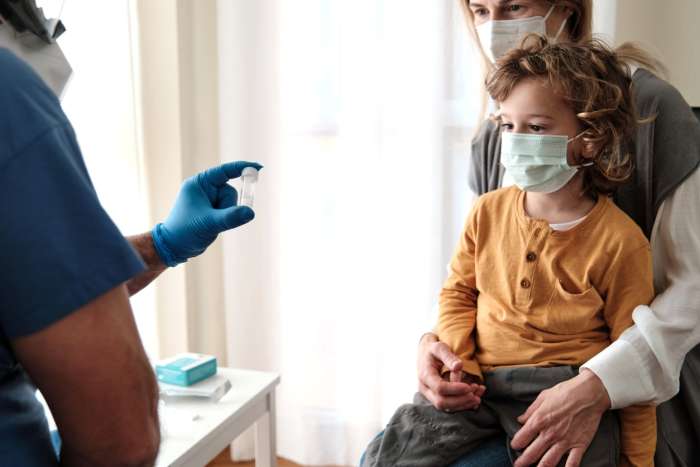Two Sars-Cov-2 (COVID) variants have been in the news recently: COVID variant Eris and COVID variant Pirola. Eris is the name given to variant EG.5, which is currently the dominant strain in the United States. Pirola, or BA.2.86, is a newer variant.
What are COVID Eris symptoms? What are Pirola’s symptoms? And how can you best protect yourself during this latest phase of the coronavirus pandemic?
Related: Do My Kids Need a COVID Booster?
Eris: The Facts
Eris, an Omicron subvariant, is currently the dominant strain in the United States (recently taking over from the Arcturus variant). It accounts for roughly 20 percent of all new COVID-19 cases (Kee, 2023), and is responsible for the current uptick in infections and hospitalizations.
Eris was first detected in China in February of 2023 and first detected in the United States in April of 2023.
The Ultimate List of Allergy Friendly Candy
While Halloween is an exciting holiday, it can also bring about the added stress of needing to check candy ingredients for parents of children with food allergies. More: The Spookiest Vampire and Witch Names for 2019 Read More
The World Health Organization has designated Eris as a “variant of interest” (WHO, 2023). This means that the variant has genetic differences that could make it more severe, better able to evade vaccines, more transmissible, or more difficult to treat (Bennett and Turville, 2023).
Health officials from the World Health Organization consider the public health risk from Eris to be “low” (WHO, 2023).
Lineage
Eris is a descendant of Omicron XBB.1.9.2.
Disease Severity
Overall, Eris is not more severe than previous COVID strains.
Transmissibility
Mutations of the spike protein mean that Eris may be more transmissible than previous variants (Cohen, 2023).
Symptoms of the Eris Variant
Possible symptoms of the Eris variant include classic COVID symptoms such as cough, loss of taste or smell, and headache. Other symptoms include fatigue, congestion, runny nose, nausea, diarrhea, vomiting, sore throat, and chest pain (Cohen, 2023).

How Contagious is Eris?
It’s thought that the Eris variant’s mutations make it slightly more transmissible than previous variants.
Eris COVID Vaccine Response
One particular mutation of Eris’s spike protein has meant that this strain more easily evades antibodies from vaccines and previous infections (Cohen, 2023).
However, because Eris is a subvariant of Omicron, scientists are currently adapting COVID-19 vaccines for Omicron XBB variants close to EG.5. These new vaccines, which are due to be released in September of 2023, will hopefully prove more effective against Eris.
In addition, bivalent vaccines, such as Moderna’s BA bivalent booster, produce a fivefold increase in antibodies effective against many variants, including Eris (Bennett and Turville, 2023).
Pirola: The Facts
Pirola, also called BA.2.86, is a new COVID-19 variant that is poised to take over from Eris as the dominant strain in many places.
Pirola is a highly mutated variant. It contains 34 mutations that differ from the formerly dominant sub-variant XBB.1.5 (Davis, 2023). Scientists are still trying to determine what this means from a healthcare standpoint.
It is believed that Pirola developed its mutations during a long-term (“long COVID”) infection of an immunocompromised person (Davis, 2023).
The WHO has designated Pirola a “variant under monitoring,” which is a lower level of concern than a “variant of interest.”
Lineage
Pirola, or BA.2.6, is considered to be a new lineage (Walrath-Holdridge, 2023), though it is descended from Omicron.
Disease Severity
It is not expected that Pirola will cause more severe disease than previous variants. Scientists predict that it will cause less severe disease and fewer deaths than earlier waves of Alpha, Delta and Omicron variants (Davis, 2023).
Transmissibility
It’s not known at this time if Pirola is more or less transmissible than other variants.
Interestingly, in the few cases that have been reported, none of the patients had traveled abroad, nor had contact with any of the other patients. It’s assumed, therefore, that Pirola has been in circulation, unmonitored, for some time (Callaway, 2023).
Symptoms of the Pirola Variant
At the time of this writing, there are too few cases of Pirola to make a definitive list of symptoms (Kee, 2023). However, it’s thought that the symptoms will resemble those of other COVID variants, such as loss of taste or smell, cough, fever, and headache.
How Contagious is Pirola?
It’s too early to tell. However, some scientists believe that the incredible number of mutations will make Pirola more transmissible than previous variants.

Priola COVID Vaccine Response
Some scientists are concerned that the 34 mutations on Pirola’s spike protein will make it more resistant to antibodies (Callaway, 2023), and possibly better able to evade vaccines.
It’s unclear whether the updated vaccines coming in September of this year will be as effective against Pirola as they are predicted to be against Eris and similar variants (Davis, 2023).
Who is Most at Risk From Eris and Pirola?
Like all COVID variants, the people at greatest risk for severe disease are people of advanced age, immunocompromised individuals, and people living with chronic illness.
Could New Variants Lead to Lockdowns and School Closures?
At this time, experts consider it unlikely that either variant will cause a public health emergency.
Staying Safe from COVID-19 Variants
So, what’s next?
- First, don’t panic!
New variants are predictable and expected.
In addition, although Eris and Pirola have mutations that may make them more transmissible, and possibly better at evading vaccines, there is no indication that either is more capable of causing severe disease.
- Next, get vaccinated.
Vaccines are our first line of defense against severe disease. Vaccines like Novavax and others also help to develop herd immunity, which can help to protect vulnerable members of society and reduce or even stop transmission (Mayo Clinic, 2023).
For current vaccine recommendations from the Centers for Disease Control and Prevention (CDC), visit the CDC’s vaccines page.
- Take protective measures.
Wash your hands often and avoid crowded spaces when possible.
COVID is transmitted primarily through particles inhaled when infected people cough, sneeze, speak, breathe, or sing. If you must be in a crowded, confined space, wear a mask.
- Test yourself.
If you believe you have contracted COVID, a test can give you and your doctor a better idea of where to go from there.
- If you experience severe symptoms, contact your healthcare provider.
No matter which strain you contract, the treatment options, including antiviral medications like Paxlovid, are the same, and your healthcare provider can give you the best advice.



